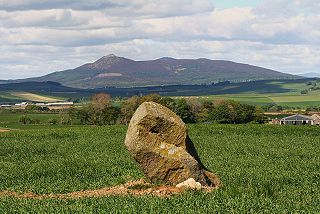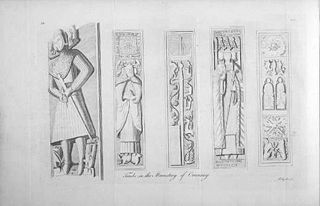Related Research Articles

The Battle of Harlaw was a Scottish clan battle fought on 24 July 1411 just north of Inverurie in Aberdeenshire. It was one of a series of battles fought during the Middle Ages between the barons of northeast Scotland against those from the west coast.

Lord of the Isles or King of the Isles (Scottish Gaelic: Triath nan Eilean or Rìgh Innse Gall) is a title of Scottish nobility with historical roots that go back beyond the Kingdom of Scotland. It began with Somerled in the 12th century and thereafter the title was held by a series of his descendants, the Norse-Gaelic rulers of the Isle of Man and Argyll and the islands of Scotland in the Middle Ages. They wielded sea-power with fleets of galleys (birlinns). Although they were, at times, nominal vassals of the kings of Norway, Ireland, or Scotland, the island chiefs remained functionally independent for many centuries. Their territory included much of Argyll, the Isles of Arran, Bute, Islay, the Isle of Man, Hebrides, Knoydart, Ardnamurchan, and the Kintyre peninsula. At their height they were the greatest landowners and most powerful lords after the kings of England and Scotland.

Robert Stewart, Duke of Albany was a member of the Scottish royal family who served as regent to three Scottish monarchs. A ruthless politician, Albany was widely regarded as having murdered his nephew, the Duke of Rothesay, and brother to the future King James I of Scotland. James was held in captivity in England for eighteen years, during which time Albany served as regent in Scotland, king in all but name. He died in 1420 and was succeeded by his son, Murdoch Stewart, Duke of Albany, who was executed for treason when James returned to Scotland in 1425, almost causing the complete ruin of the Albany Stewarts.

Alexander Stewart, Earl of Buchan, called the Wolf of Badenoch, was a Scottish royal prince, the third son of King Robert II of Scotland by his first wife Elizabeth Mure. He was Justiciar of Scotia and held large territories in the north of Scotland. He is perhaps best remembered for his destruction of the royal burgh of Elgin and its cathedral. His sobriquet was earned due to his notorious cruelty and rapacity, but there is no proof that it was used during his lifetime.
The Earl or Mormaer of Ross was the ruler of the province of Ross in northern Scotland.

Clan Donald, also known as Clan MacDonald, is a Highland Scottish clan and one of the largest Scottish clans. The Lord Lyon King of Arms, the Scottish official with responsibility for regulating heraldry in that country, issuing new grants of coats of arms, and serving as the judge of the Court of the Lord Lyon, recognises under Scottish law the High Chief of Clan Donald. Historically the chiefs of the Clan Donald held the title of Lord of the Isles until 1493 and two of those chiefs also held the title of Earl of Ross until 1476. Queen Mary of Denmark is member of Clan Donald.
Euphemia I, also called Euphemia of Ross and Euphemia Ross, and sometimes incorrectly styled Euphemia Leslie and Euphemia Stewart, was a Countess of Ross in her own right.

John Stewart, Earl of Buchan was a Scottish nobleman and soldier who fought alongside the Kingdom of France during the Hundred Years War. In 1419, he was sent to France by his father the Duke of Albany, Regent of Scotland, with a Scottish army of 6,000 men. Stewart led the combined Franco-Scottish army at the Battle of Baugé on 21 March 1421, where he comprehensively routed an English force under Thomas of Lancaster, Duke of Clarence.

Alexander Stewart was a Scottish nobleman, Earl of Mar from 1404. He acquired the earldom through marriage to the hereditary countess, and successfully ruled the northern part of Scotland.

Donald, Lord of the Isles, was the son and successor of John of Islay, Lord of the Isles and chief of Clan Donald. The Lordship of the Isles was based in and around the Scottish west-coast island of Islay, but under Donald's father had come to include most of the isles and the lands of Somerled, the King of the Isles in the 12th century, Donald's predecessor, including Morvern, Garmoran, Lochaber, Kintyre and Knapdale on the mainland.

Alexander of Islay or Alexander MacDonald was a medieval Scottish nobleman who succeeded his father Domhnall of Islay as Lord of the Isles (1423–1449), later rising to the rank of Earl of Ross (1437–49). His lively career, especially before he attained the earldom of Ross, led Hugh MacDonald, the 17th century author of History of the MacDonalds, to commemorate him as "a man born to much trouble all his lifetime". Alexander allied himself with King James I of Scotland against the power of the Albany Stewarts in 1425 but, once the Albany Stewarts were out of the way, Alexander quickly found himself at odds with the new king. War with King James would initially prove Alexander's undoing, and would see the King's power in Scotland greatly increased, but at the Battle of Inverlochy Alexander's army prevailed against the forces of the King. Alexander died in 1449, having greatly extended his family's landed wealth and power. He was buried, not in the Isles of his ancestors, but at Fortrose Cathedral in his mainland Earldom of Ross.
Aonghas Óg was a Scottish nobleman who was the last independent Lord of the Isles. Aonghas became a rebel against both his father and the Scottish crown, in a civil clan war which would see the end of the independent Lordship of the Isles.
Alexander Leslie, Earl of Ross was a Scottish nobleman. Born between 1367 and 1382, he was the son of Walter Leslie, Lord of Ross and Euphemia I, Countess of Ross. In around 1394, or not later than 1398, he became Earl of Ross and sometime before 1398 he married Isabel Stewart, daughter of Robert Stewart, Earl of Fife who became Robert Stewart, Duke of Albany. They had one child, Euphemia. He died at Dingwall, Scotland on 8 May 1402.
Euphemia II, Countess of Ross was the daughter of Alexander Leslie, Earl of Ross and his wife Isabella Stewart, daughter of Robert Stewart, 1st Duke of Albany. She was the only child and heir of Earl Alexander, and succeeded to the earldom de jure upon his death in 1402.

The Battle of Bealach nam Broig was fought between Scottish clans from the lands of north-west Ross, against north-eastern clans of Ross who supported the Earl of Ross. The actual date of the battle is debated, it probably occurred in 1452 but the Conflicts of the Clans suggests a date as early as 1299.

The Battle of Dingwall was a Scottish clan battle said to have taken place in the year 1411, in Dingwall in the Scottish Highlands. It was fought between the Clan Mackay and the Clan Donald.
Hugh Munro, 9th Baron of Foulis was a 14th – 15th century Scottish soldier and said to be 12th chief of the Clan Munro in the Scottish Highlands. Hugh was seated at Foulis Castle in Ross-shire, Scotland. Although Hugh is traditionally the 9th Baron and 12th overall chief of the clan, he is only the 2nd Munro chief that can be proved by contemporary evidence.

The Battle of Lochaber was fought in 1429, in the Scottish Highlands, between the forces of Alexander of Islay, Earl of Ross, Lord of the Isles and chief of Clan Donald against the Royalist army of King James I of Scotland.

Dingwall Castle was a medieval fort and royal castle in the town of Dingwall, eastern Ross-shire, Scotland.
Angus Du Mackay, 7th of Strathnaver was the seventh chief of the Clan Mackay, a Highland Scottish clan. He is recorded in the 15th-century Scottish chronicle, Scotichronicon, as Enneas-en-Imprissi meaning Angus the Absolute due to his power of commanding 4000 men.
References
- ↑ MacDonald, Iain G., Donald of the Isles and the Earldom of Ross: West-Highland Perspectives on the Battle of Harlaw (‘Macdonald had the victory but the governor had the printer’) June, 2011, published for Harlaw Remembered, commemorating the 600th anniversary of the Battle of Harlaw by The Elphinstone Institute, University of Aberdeen. See also the Irish Annals of Connacht under the year 1411, “Mac Domnaill of Scotland won a great victory over the Galls of Scotland."
- Boardman, Stephen, The Early Stewart Kings: Robert II and Robert III, 1371-1406, (Edinburgh, 1996)
- Brown, Michael, James I, (East Linton, 1994)
- Oram, Richard, "The Lordship of the Isles, 1336-1545", in Donald Omand (ed.) The Argyll Book, (Edinburgh, 2005), pp. 123–39
- Paul, James Balfour, The Scots Peerage, Vol. VII, (Edinburgh, 1910)